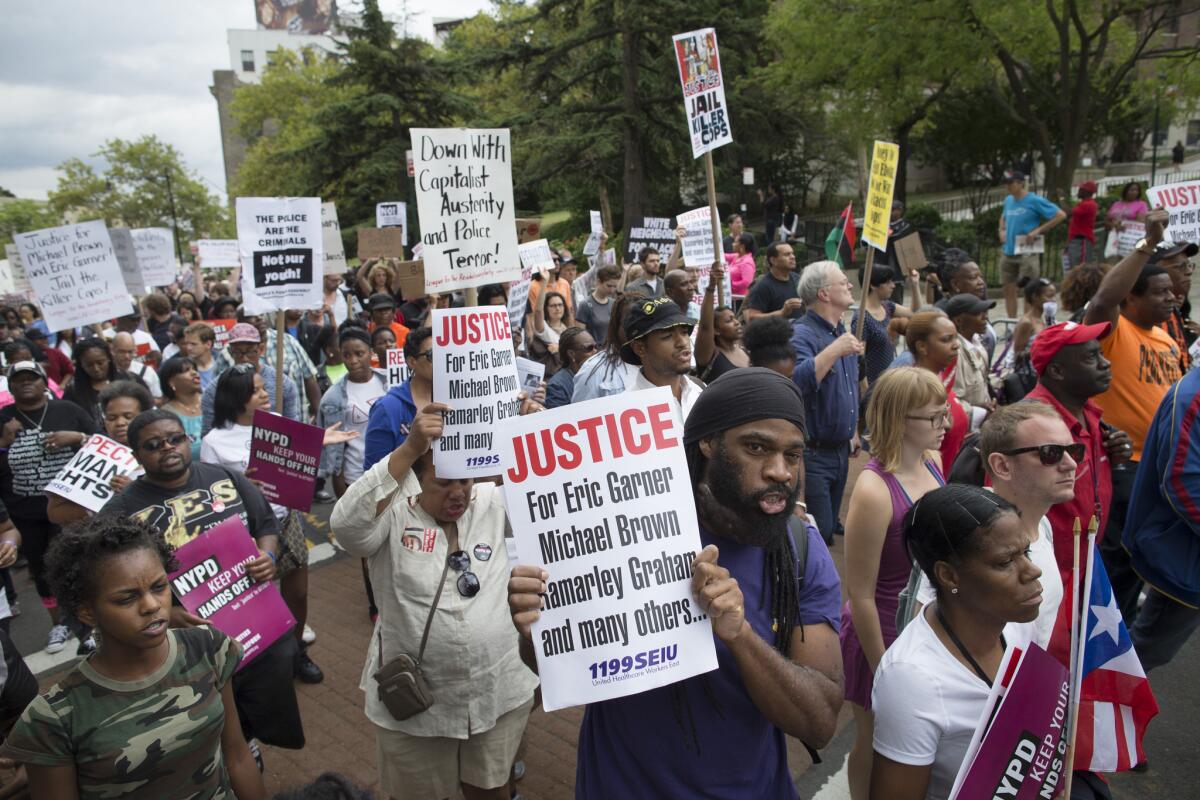Grand jury transcript from Eric Garner case to remain sealed, court says

Demonstrators in August 2014 protest the death of Eric Garner in Staten Island.
- Share via
Reporting from New York — An appellate court ruled Wednesday that most details of the grand jury proceeding that cleared a white policeman in the death of Eric Garner should remain sealed, a setback to activists who say Garner, an unarmed black man, was murdered.
In its decision, the state Supreme Court’s 2nd Department Appellate Division said the appellants failed to provide a “compelling and particularized need” for the release of the transcripts.
The ruling by the four-judge panel affirms a lower court’s decision in March. The lower court said the public interest in preserving grand jury secrecy outweighed the public interest in disclosure.
The New York Civil Liberties Union, one of the appellants, said after Wednesday’s ruling that it would take the case to a higher court.
“Secrecy triumphs over #justice in today’s #ERICGARNER grand jury decision,” Donna Lieberman, the group’s executive director, said on Twitter.
In a statement, the organization’s legal director, Arthur Eisenberg, announced plans to appeal. Eisenberg said the unsealing of the transcript was needed to foster informed debate on alleged police misbehavior, and on conflicts that might arise when local prosecutors are faced with prosecuting the officers with whom they work.
“The Eric Garner case presented a special circumstance for grand jury disclosure to advance the need of an informed electorate,” Eisenberg said. “The court’s opinion didn’t even consider that crucial question.”
Garner died on July 17, 2014, during an altercation with police officer Daniel Pantaleo, who accused him of selling illegal cigarettes on a Staten Island, N.Y., sidewalk. A bystander’s video captured Garner’s final moments as Pantaleo put an arm around Garner’s neck and held him down as Garner said repeatedly, “I can’t breathe.”
The city’s medical examiner ruled the death a homicide due to compression of the neck and chest. Five months later, a grand jury declined to indict Pantaleo, touching off nationwide protests and fueling debate over the deaths of unarmed blacks at the hands of law enforcement officers.
Pantaleo remains on desk duty and is the subject of an internal police department investigation. Police union leaders say he did nothing wrong and blame the scuffle on Garner, who they say refused to cooperate with officers.
Garner’s death has been one of the most divisive issues in New York, pitting police against protesters and some public figures, including Mayor Bill de Blasio and the city’s public advocate, Letitia James.
De Blasio angered police in December, after the grand jury’s decision, by talking about the concern he had for his biracial son, Dante, during encounters the teenager might have with law enforcement officers.
Later that month, after two policemen were slain by a gunman who had posted anti-cop rants online, officers turned their backs on De Blasio at the funerals to protest what they said was the mayor’s lack of support.
James was among those who sought to make public the grand jury transcripts, and she also vowed to appeal Wednesday’s ruling.
“The public deserves to know what happened with that grand jury and why what we saw with our eyes did not match the failure to indict those responsible for Eric Garner’s death,” she said in a statement.
The decision came hours after a white University of Cincinnati officer was indicted on a murder charge in the fatal shooting of an unarmed black motorist.
As in Garner’s death, much of the altercation that led to the driver’s death was caught on video, via a camera worn by the officer. Prosecutors said the video showed that the officer, Ray Tensing, was out of line when he opened fire on Samuel DuBose during a July 19 traffic stop.
In the flurry of social media comments that followed the court decision, activists said the Cincinnati indictment did not make it any easier to accept the New York court’s outcome.
This month, the city settled with Garner’s family for $5.9 million. Garner’s mother and widow, though, have said they won’t stop protesting until someone is indicted in Garner’s death.
The appellants face difficult odds in getting the grand jury transcripts released. Under New York law, grand jury information remains secret, and only a prosecuting district attorney can apply to make it public.
Richmond County Dist. Atty. Daniel Donovan applied for and received a limited release of information after the grand jury decision. But the court allowed Donovan to disclose only what type of evidence the jurors reviewed and the number of witnesses they heard testify.
Thousands of pages of witness testimony, Garner’s autopsy report and the exact charges Donovan pursued against Pantaleo remained sealed.
Follow @TinaSusman for national news.
ALSO:
University of Cincinnati officer charged with murder in Sam DuBose shooting
Maddy Middleton killing: ‘We are going to bring him to justice,’ D.A. says
More millenials are living at home, and you can’t blame the economy
More to Read
Sign up for Essential California
The most important California stories and recommendations in your inbox every morning.
You may occasionally receive promotional content from the Los Angeles Times.











